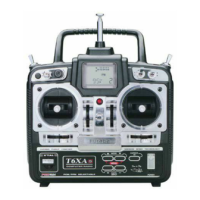9. Revolution Mix Setting
Revolution mixing (
REVO
) uses the tail
rotor to suppress the torque reaction of the
main rotor due to changes in collective pitch.
It is disabled whenever Idle-Up or Throttle
Hold are activated.
REVO
may be set on either side of the stick
(note the letters
R/U
and
L/D
displayed).
Adjust
REVO
mixing for both travel directions
as described in the trimming instructions
following.
Idle-Up & Throttle Hold
Your system is already programmed to
provide Idle-up [
IDLE
] and Throttle Hold
[
HOLD
]. Idle-up is typically used for 540°
stall turns, looping, and rolling stall turns;
throttle hold is used to disengage the throttle
during autorotations. After activation, these
functions are switched on as follows:
• Idle-up [
IDLE
] –
ON
at Switch E’s forward
position. Idle-up also turns on Rudder offset
function
• Throttle Hold [
HOLD
] –
ON
at Switch D
forward position.
When these two switches are OFF, the
radio is set up for regular hovering and flight.
As these functions are switched on or off,
HOLD
has highest priority, followed by
IDLE
.
Regular settings are when both are off.
10. Rudder Offset Setting
The Rudder Offset menu [
R-OF
] is only
turned on when Idle-up has been activated.
Rudder trim may be offset to different
positions so that the model flies straight ahead
during normal flight. Recommended settings
are small, from 6% to 10% or as needed.
11. Throttle Hold Setting
Throttle hold (
HOLD
) commands the
throttle to a preset position near idle and
disconnects it from pitch when activated.
Move to the
HOLD
menu and activate by
pressing the (+) key, then move switch D to
the forward position. Set the hold position to
maintain engine speed near idle without
engaging the main rotor clutch.
12. Dual Rate Settings
If you find that your aileron and elevator
controls are too sensitive, you may set dual
rates to reduce them. Use the dual rate (
D/R
)
window to adjust them to the desired amount
of response when the switch is flipped.
If you want both dual rate circuits to be
controlled by a single switch, use mode 2 in
the
DRSW
menu. Otherwise, leave it at mode
1.
12. Trim Memory
Once your chopper is flying the way you
like, memorize the trim positions with the
TMEM
window.
This concludes the example setup
procedure for helicopters. Be sure to browse
through the pages following this example to
see the details about the menus for helicopters.
– 49 –

